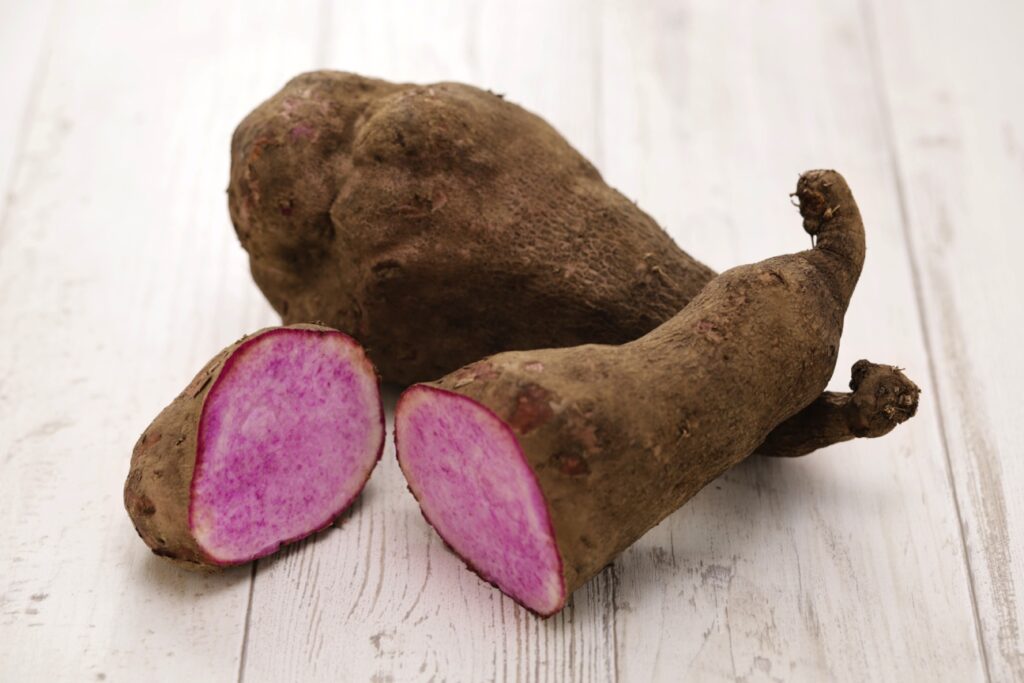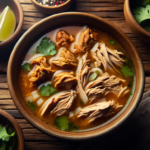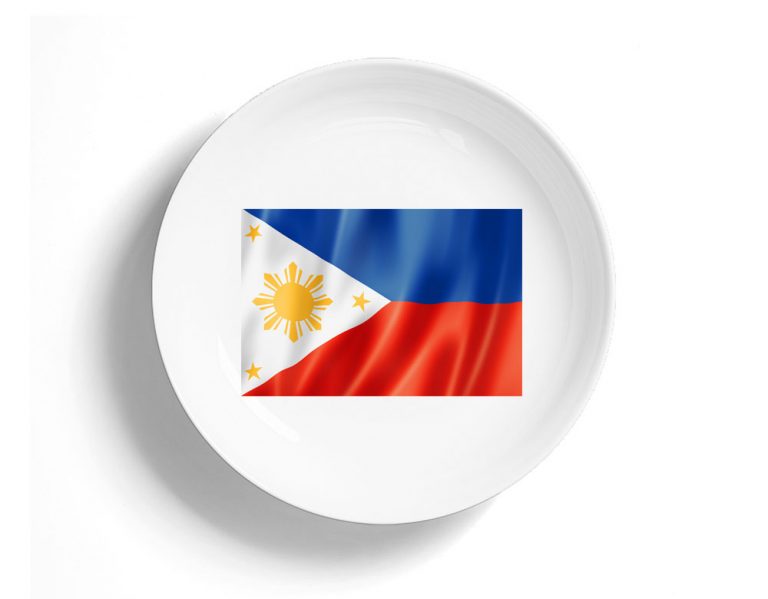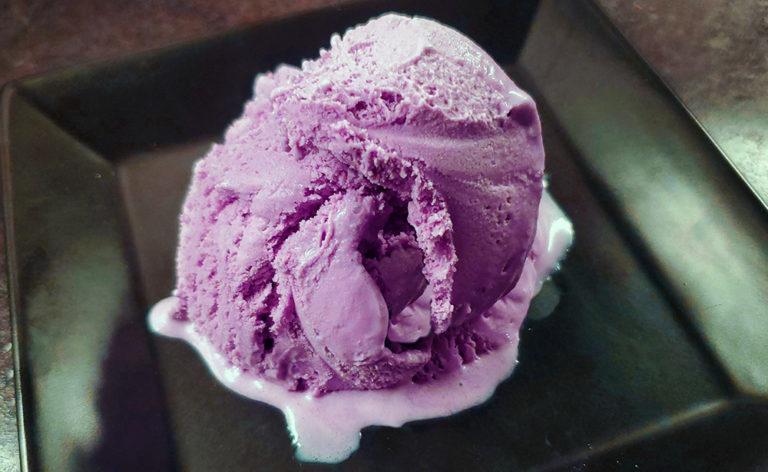
What is ube?
Ube is a naturally purple-colored tuberous root also known as the purple yam. It is traditionally pronounced “OOO-beh,” not “OOO-bae” nor “YOU-bae” since there are no long vowel sounds in Tagalog. It is native to the Philippines and is a popular food ingredient in many Filipino desserts and pastries. Thanks to its striking purple hue and familiar flavor profile, it has been growing in popularity in other countries as well.
Due to its visually appealing color and high “Instagramability,” it reached fever pitch in the mid-2010s becoming the “it” flavor of many trendy treats like cronuts, macarons, rolled ice cream, shaved snow, bubble waffles, boba milk teas, and milkshakes and lattes.
This purple yam is commonly mistaken for other starchy vegetables, specifically taro and the Okinawan sweet potato, which are also used as primary ingredients in purple-colored foods.
Ube (purple yam) vs. Taro
Ube is not Taro. The Philippine purple yam is frequently confused with taro (and vice versa) because they are both found in purple desserts. However, they are two completely separate types of vegetables.
Where do they come from?
According to the Philippine Journal of Crop Science, the Philippines is known to produce the greatest variety of purple yams. Although there is no documented proof of the exact year this crop was first used in Filipino cooking, it was first mentioned in the Tagalog/Spanish dictionary, Vocabulario de la lengua tagala, written in 1613. A Filipino cookbook written in 1918, Condimentos Indigenas, includes a pumpkin jam recipe that uses a very similar process to making the traditional Filipino dessert, ube halaya. It has become a staple ingredient in many Filipino desserts.
Taro, on the other hand, is primarily produced in Nigeria. It has been traced back to multiple regions: South Asia, East Asia, Southeast Asia, Papua New Guinea, and northern Australia. However, recent studies reveal that it is indigenous to Southeast Asia. It has become as staple ingredient in African, Polynesian and South Asian foods.
What do they look like?
Although both ube and taro are tuberous root vegetables, they have very distinct features.
Ube looks a bit like a potato when it’s dug out from the ground. It has a rough brown outer skin, but is much better known for its internal “meat,” which is a vibrant purple.

raw ube
Taro resembles a small coconut and can be likened to a hairy potato. Its exterior has a brown rough skin with thin root-like extensions while its interior is whitish and is “sprinkled” throughout with tiny purplish flecks.

What do they taste like?
The flavor of both of these vegetables includes a bit of sweetness and nuttiness. They are also starchy in texture. So what makes them different?
Ube is distinctly sweeter than taro and its overall taste is also richer than taro. Its flavor is similar to vanilla or white chocolate. Many have claimed that its nuttiness is comparable to pistachios (a green nut that is a part of the cashew family). The texture is softer than taro because it is a yam.
Taro is generally milder in flavor and has lighter notes of vanilla mixed with sweet potato. It is also naturally a bit harder in texture and more potato-like.
How to cook with ube vs. with taro
Ube has been deeply rooted (yes, we went there) in traditional Filipino food culture. It’s commonly used in Filipino desserts like ube halaya (a purple sticky pudding), cakes, pancakes, pastries, ice cream and halo-halo.
Taro is used in a wider variety of dishes, both sweet and savory. These include breads, curries, stews, smoothies, poi, and chips.
What are some of their health benefits?
Ube is naturally nutritious as it is a great source of vitamin C, potassium and complex carbohydrates. These provide many health benefits.
Taro is also healthy and is a high in vitamins A, C and E as well as magnesium, potassium, iron, fiber and complex carbohydrates (amylose and amylopectin).
Keep in mind that the exterior of this benign-looking vegetable is unexpectedly toxic. Taro contains oxalate crystals just below the surface of the peel which can result in numbness, skin rashes, or mouth and throat irritation. So, if you see raw taro, leave it to the pros to handle it. If for some reason you must interact with raw taro, it is best to wear gloves and a quality mask to prevent any accidental contact with its toxins. The proper cooking of taro neutralizes these toxins.
Ube vs. Okinawan purple sweet potato

What’s the difference between ube and an Okinawan purple sweet potato? Okinawan sweet potatoes (a.k.a. purple sweet potatoes, bene-imo, Hawaiian sweet potato and uala) are the only sweet potatoes of the bunch. Technically, they are not potatoes but are members of the Morning Glory family. It is believed that they originated from the Aztecs of South America and were transported by the Spaniards to the Philippines and China in the late 15th century. It eventually made its way to Japan in the 1600s.
They are slightly more similar in color to taro on the outside due to their chalky white skin and look slightly more like Philippine purple yams on the inside due to their purple interior.
These purple sweet potatoes are closer to ube in sweetness than taro, but they have a very dry starchy texture. In addition, they have a slightly bitter aftertaste.
They are commonly used in many dishes that potatoes are normally used in and are often baked, boiled, fried, roasted, or steamed.
Like ube and taro, the Okinawan sweet potato is also high in nutrients as it is rich in Vitamin A and C, fiber, iron and potassium.
Where to buy Ube?
You can find traditional ube-based foods in most specialty Filipino dessert shops or Filipino restaurants that serve traditional desserts. View this map to find ube ice cream, pancakes, donuts, and other desserts:
Buy ube halaya from SweetTummyGoods on Etsy here.

Buy ube pan de sal from The Purple Bakeshop on Etsy here.

Buy ube crinkle cookies by Bunso Breads on Etsy here.

Buy ube mochi cake balls from Bunso Breads on Etsy here.

If you’re looking for something a little more trendy, check out some places on Glutto right here.
How can I make Ube Halaya?
There are many different desserts and dishes you can make with the Philippine purple yam. The absolute easiest way is to mix in some pre-made ube halaya into whatever dessert you are making. But, if you want a more authentic recipe, here is how to make traditional ube halaya at home.

Ube Halaya
Ube halaya is a thick sweet pudding or jam made of purple yams. It is the most traditional ube dessert of the Philippines.
Ingredients
- 2 lbs Filipino purple yam
- 14 oz condensed milk
- 12 fl oz evaporated milk
- 1/2 lbs butter
- 1 cup sugar
- 5-10 drops drops purple food coloring
Instructions
- First, boil the purple yams until soft. Then blend or mash thoroughly and evenly.
- Put the butter, sugar, condensed milk and evaporated milk together in a pot and heat until the butter is completely melted. Mix the ingredients completely.
- Add the mashed purple yams and mix everything together in a thick paste. Add drops of food coloring until desired color is reached.
- Put the mix into a container or mold and refrigerate at least 2 hours.
- Serve with butter. Enjoy!
Recommended Products
Glutto earns a tiny commission from qualifying Amazon purchases.
Did you make this recipe?
Please leave a comment on the blog or share a photo on Instagram
Discover more about ube
Ube Donuts: purple glaze all in my brain
Ube donuts (also ube doughnuts) have gained prominence as international flavors became more sought after…
Ube Pancakes: flap these purple jacks
Ube pancakes, a purple version of the traditional breakfast pancake, have gained mainstream attention thanks…
Ube Ice Cream: stay cool in these shades of purple
Ube ice cream is the most popular type of ube dessert across the world. While…
Ube Health Benefits: harness the power of purple
Ube isn’t just an eye-catching Filipino food, it’s also a rich source of essential nutrients…
Ube: purple yam is what’s for dessert
What is ube? Ube is a naturally purple-colored tuberous root also known as the purple…

















